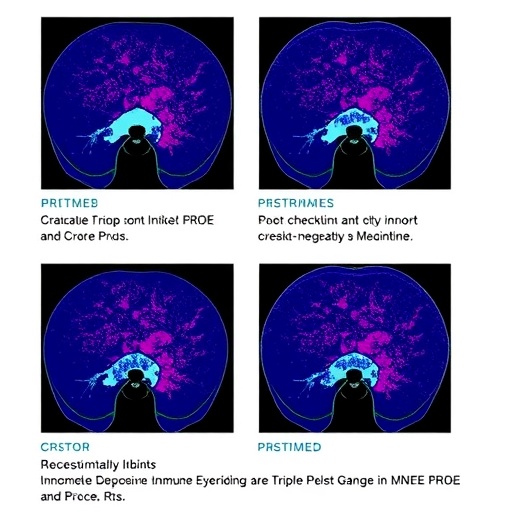The landscape of triple-negative breast cancer (TNBC) treatment is witnessing a transformative shift with the rising prominence of immune checkpoint inhibitors (ICIs). A recent systematic review and meta-analysis published in BMC Cancer provides a comprehensive evaluation of the safety and efficacy of ICIs in treating TNBC, offering critical insights into their therapeutic potential and associated risks. This extensive study synthesizes data from randomized controlled trials (RCTs) to paint a nuanced picture of how ICIs influence patient outcomes and adverse event profiles.
Immune checkpoint inhibitors have emerged as a groundbreaking class of immunotherapies that unleash the body’s immune system to recognize and attack cancer cells by targeting regulatory pathways in T cells. In the context of TNBC, a subtype notorious for its aggressive nature and limited targeted treatment options, ICIs represent a beacon of hope. The research team embarked on an exhaustive search of PubMed, Embase, and the Cochrane Library, collating evidence from 13 RCTs encompassing 5,890 TNBC patients to determine the clinical impact of ICIs.
The study’s results reveal a complex balance between efficacy and safety. While ICIs significantly enhance pathological complete response (pCR) rates — a crucial endpoint indicating the absence of residual invasive cancer after treatment — and improve survival metrics, they concurrently increase the risk of serious treatment-related adverse events (trAEs) and immune-related adverse events (irAEs). This underscores the dual-edged nature of immunotherapy, where enhanced immune activation must be carefully managed to mitigate harmful side effects.
Specifically, the meta-analysis demonstrates a 55% increase in pCR rates among TNBC patients receiving ICIs compared to controls, alongside a 16% reduction in the risk of death and a 31% reduction in progression or relapse. These compelling efficacy data spotlight ICIs as formidable agents in improving long-term patient outcomes, potentially altering the prognosis of this challenging cancer subtype. Enhanced pCR is also associated with improved overall survival, reinforcing the clinical relevance of these findings.
In parallel, the safety profile presents consequential challenges. The incidence of serious trAEs, defined typically as Grade 3 or higher adverse events, rose by 41% with ICI therapy. Furthermore, ICIs significantly elevated the occurrence of both any grade and severe (Grade ≥ 3) immune-related adverse events. These irAEs stem from the unintended activation of immune mechanisms against normal tissues, manifesting as endocrinopathies, pneumonitis, and other systemic toxicities.
Among the irAEs, the most frequently reported conditions included hypothyroidism, hyperthyroidism, pneumonitis, adrenal insufficiency, and infusion-related reactions. These adverse reactions highlight the complexity of immune modulation in cancer therapy, necessitating vigilant monitoring and prompt management to ensure patient safety while maintaining therapeutic benefit. The variability in irAE incidence among different ICIs also suggests that individual agents may carry distinct toxicity profiles.
Notably, the network meta-analysis aspect of the study positioned atezolizumab, an anti-PD-L1 antibody, as having the lowest risk for both any grade and severe irAEs based on surface under the cumulative ranking curve (SUCRA) metrics. This finding has practical implications, potentially guiding clinicians in selecting ICIs that optimize the risk-benefit ratio for TNBC patients and tailoring treatment strategies according to individual tolerability.
The investigators also emphasize the importance of therapeutic context, as the inclusion criteria spanned diverse trial designs and stages of TNBC. This heterogeneity reflects real-world clinical scenarios but underscores the necessity for personalized medicine approaches. Future research may focus on biomarker identification to stratify patients likely to derive maximum benefit with minimal harm from ICIs.
Mechanistically, these immune checkpoint inhibitors function by blocking proteins such as PD-1, PD-L1, or CTLA-4 that tumors exploit to evade immune detection. By disrupting these inhibitory signals, ICIs restore T-cell activity, fostering robust antitumor immune responses. However, this immune reactivation can inadvertently target self-antigens, explaining the observed irAEs that resemble autoimmune phenomena.
The meta-analysis methodology, leveraging robust statistical techniques and comprehensive literature synthesis, lends high confidence to these conclusions. It balances the imperative to prolong survival and achieve remission against the critical concern of quality of life impacted by treatment-related toxicity. Consequently, this study sets an evidence-based framework for clinicians navigating the incorporation of ICIs into TNBC therapeutic regimens.
As the field advances, integrating ICIs with other modalities such as chemotherapy, targeted agents, or radiation therapy holds promise. The synergistic potential could further amplify clinical outcomes while mitigating adverse events through dose optimization and scheduling. Importantly, vigilant long-term follow-up will be essential to understand delayed toxicities and durability of response.
In summary, this systematic review and meta-analysis presents a landmark appraisal of immune checkpoint inhibitors in the management of triple-negative breast cancer. It clearly establishes ICIs as potent agents that can substantially improve pathological response and survival rates. Yet, it impels caution given the elevated risks of serious adverse events, particularly immune-related toxicities, which require proactive clinical management.
These findings reaffirm the transformative potential of immunotherapy in oncology, highlighting the ongoing evolution of TNBC treatment paradigms. They also underscore the urgency of developing predictive biomarkers and supportive care algorithms to optimize patient outcomes. As research continues to unravel the intricacies of immune regulation, the vision of personalized, precise, and safe immunotherapy for aggressive breast cancers moves closer to reality.
This comprehensive analysis provides the oncology community with critical insights to inform clinical decision-making and future investigative directions. The balancing act between empowering the immune system against cancer and safeguarding normal tissue integrity remains at the forefront of innovation. By illuminating both the benefits and risks of ICIs in TNBC, this study contributes substantially to shaping the future of breast cancer therapeutics.
With continued multidisciplinary collaboration and patient-centered research, there is renewed hope for transforming triple-negative breast cancer from an aggressive prognosis into a manageable condition with durable remission and extended survival.
Subject of Research: Safety and efficacy of immune checkpoint inhibitors in patients with triple-negative breast cancer
Article Title: Safety and efficacy of immune checkpoint inhibitors in patients with triple-negative breast cancer: a systematic review and meta-analysis
Article References: Yan, X., Zhang, X., Wang, Z. et al. Safety and efficacy of immune checkpoint inhibitors in patients with triple-negative breast cancer: a systematic review and meta-analysis. BMC Cancer (2025). https://doi.org/10.1186/s12885-025-15127-3
Image Credits: Scienmag.com
DOI: https://doi.org/10.1186/s12885-025-15127-3
Tags: adverse event profiles in cancer treatmentcancer immunotherapy advancementsefficacy and safety of ICIsimmune checkpoint inhibitorsimmunotherapy for aggressive cancerpathological complete response ratesrandomized controlled trials in oncologysystematic review and meta-analysistargeted treatment options for breast cancertherapeutic potential of immune therapiesTNBC patient outcomestriple negative breast cancer treatment





